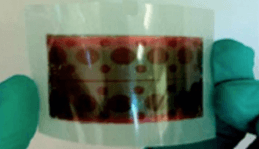Thin-Film Solar Cells Stick Anywhere
on

Researchers at Stanford University (USA) have developed novel peel-and-stick thin-film solar cells. Unlike standard thin-film solar cells, they do not require direct fabrication on the final substrate. This avoids the difficulties associated with putting solar cells on unconventional materials, vastly expanding the potential applications of solar power. Although thin-film technology promised to boost the flexibility of solar power, thin-film cells are conventionally fixed on rigid silicon substrates due to unexpectedly severe problems with unconventional substrates.
Unconventional substrates are difficult because they typically have irregular surfaces and they are not compatible with the thermal and chemical processes used to produce solar cells. The peel-and-stick approach gets around this problem and gives thin-film solar cells unprecedented attachment potential while reducing general cost and weight. The researchers have attached prototype thin-film solar cells to paper, plastic and window glass, among other materials, without losing any of the original cell efficiency.
The new process involves a unique composite of silicon, silicon dioxide and metal. First, a 300-nm nickel film is deposited on a silicon/silicon dioxide wafer. Thin-film solar cells are then deposited on the nickel layer utilizing standard fabrication techniques, and covered with a layer of protective polymer. A thermal release tape is then attached on top of the thin-film solar cells to assist in their transfer from the production wafer to a new substrate. The wafer is submerged in water at room temperature and the edge of the thermal release tape is peeled back slightly, allowing water to seep into the interface between the nickel and silicon dioxide. The solar cell is thus freed from the hard substrate but still attached to the thermal release tape. After the tape and solar cell are heated to 90°C for several seconds, the cell can be applied to virtually any surface using double-sided tape or other adhesive. Finally, the thermal release tape is removed, leaving just the solar cell attached to the chosen substrate.
Previous efforts to fabricate thin-film solar cells on flexible substrates required modifications to existing processes or materials. According to the researchers, the main contribution of their work is that it allows thin-film solar cells to be fabricated without modifying any existing processes, facilities or materials, and they have demonstrated the process on a more diverse array of substrates than ever before.


Discussion (0 comments)